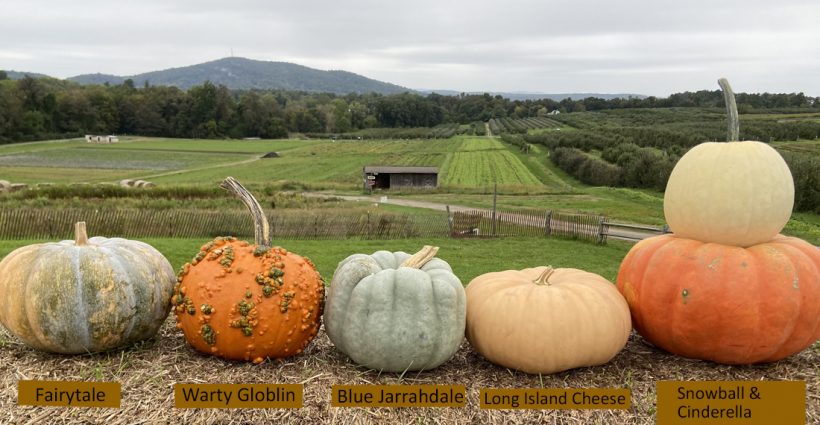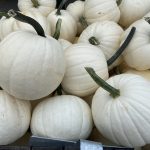designed for the way women work.

Pumpkins: The stuff of fairytales — and more! by Jeannette Ross
Category: Plant Ideas & Info, Presenting "The Curious Gardener", Recipes
Cinderellas, snowballs, goblins and knuckleheads. Knuckleheads?
You know them by their all-encompassing name: pumpkins.
With fall arriving just last week, farm fields and farm market tables are groaning with pumpkins, those multi-colored signs of the season from the Cucurbita genus (the Latin word for ‘gourd’).
While orange sugar pumpkins and big jack-o’-lantern pumpkins are commonly seen in fall displays, there are many more varieties available for eating and decorating. Perhaps one of their most appealing attributes is their names.
With that in mind, you’ve got to love the Knucklehead, one of a group of special pumpkins known as Superfreak, developed for their warty appearance. Despite it’s name, the Knucklehead (Cucurbita pepo) is quite diverse, useful for carving or as a fall decoration, as well as being edible, primarily for savory dishes.
Edible pumpkins are prized not only for their flesh, which contains beta-carotene, magnesium, vitamin A and potassium, but also for their seeds, which provide a toasted snack of healthy fats, fiber, protein, and minerals including manganese and iron. Size matters with pumpkins. The larger they are, the less appealing they are for cooking since their flesh tends to be stringy and more watery than smaller pumpkins.
The Knucklehead is primarily orange, with orange warts and a touch of green. Along a similar vein, very popular with home gardeners is the Warty Goblin, a round orange shell with dark green and yellow warts that complement its handsome green stem. This ghoulish gourd also comes in a mini-size, and as one chef said, once you get past the idea of the warts, these pumpkins are edible.
So, maybe warts are not your thing, how about the peanut pumpkin? This heirloom variety (Cucurbita maxima “Galeux d’Eysines”) has more of a pink shell with tan-colored peanut-like growths all over. The peanuts develop from a buildup of excess sugar in the flesh of the pumpkin. This leads us to: how sweet is this pumpkin? Very sweet it turns out, making it ideal for desserts such as pies, breads, cookies and cheesecake. An added benefit is that because this is not a hybrid, seeds can be saved and planted the following year for more peanut pumpkins.

There are still more colors and shapes to choose from. Blue Hubbard squash and North Georgia Candy Roaster are considered more squash than pumpkin (judging by their common names), but both are in the Cucurbita genus and make excellent ‘pumpkin’ pie. (click here for our recipe). There is the bluish-gray Jarrahdale pumpkin which has more of a blocky shape suitable for stacking in a holiday tableau. Another blue pumpkin is the Queensland Blue, of similar shape. Both belong to the Curcubita maxima family and both are sweet. They contrast nicely with orange pumpkins as well as white pumpkins.
Yes, ghostly white pumpkins. One type is the aptly named Snowball (Cucurbita pepo), a round, ribbed pumpkin with a white shell and elegant green stem. While this pumpkin is edible, it’s smooth skin makes it a favorite for people who like to paint them. Other types of white pumpkins are Baby Boo, Lumina, Casper, and Silver Moon. Super Moon, true to its name, is a variety that can grow to 90 pounds!
Don’t let the name of the Long Island Cheese (Cucurbita moschata) put you off. It has nothing to do with dairy products. Apparently, this heirloom variety is so named because it is popular on Long Island and resembles a wheel of cheese. Thus, it is flatter in shape with buff-colored skin, weighs about six to 10 pounds and is known as a very good keeper. It is especially good for making pies.
No discussion of pumpkins would be complete without Cinderella and Fairytales. Fairytale pumpkins are large, flat members of the Cucurbita moschata species that originated in the Caribbean. They are also known as Musquee de Provence and Moscata di Provenza. With flesh similar to a butternut squash, Fairytales can be cooked in all the usual pumpkin ways. They can be used in just about any recipe that calls for winter squash.
Because of their shape Fairytales are sometimes confused with Cinderella pumpkins. These are often considered some of the most beautiful pumpkins because of their deeply colored orange and scarlet skin and shape that some find reminiscent of Cinderella’s coach. This pumpkin is an heirloom known as Rouge Vif D’Etampes, developed in France, coming to the U.S. in the 1880s. Grow it in your garden, use it for pies, soups, breads and holiday decor. There’s not an ugly step-sister in the bunch.
These pumpkins generally take 100 days to maturity and seeds are available from most well-known seed suppliers. If you leave a pumpkin in your garden over the winter don’t be surprised if one of its seeds germinates and grows a new pumpkin next year.



I love the description “tables groaning with pumpkins!!
Very interesting article about pumpkins. I have 2 pumpkin patches this year which I didn’t plant. They grew in the field behind my property from pumpkins thrown out there last fall. Well over 40 Warty, Knuckleheads, Gourds and little ghost pumpkins. My daughter is decorating her front yard with all of these. I also had many light green/yellow pumpkins too. Not sure if they are a cross from some of the others. It has been fun sharing them with many people. Hoping next year, I can see a bigger pumpkin patch. Also, glad to see they are edible. Thank you for the pictures of the pumpkins!
Thank you for this article. I am looking to buy pumpkins to feed the deer this winter and I like the idea of the peanut pumpkin.